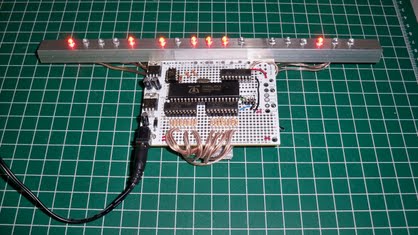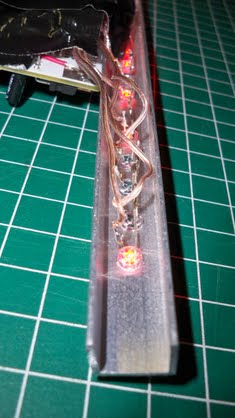
{ [ ] Projects >>> [Hardware] - [Software] - [Class] - [Other] - [Failed] -|!|!|- [Resources] - [Biography] - [Contact] - [ ] }
The Bacchus Clock
Note: This project was in response to a contest held by Nick of Gadget Gangster (GG).The Bacchus Clock is a binary LED clock based on the Propeller. There isn't really anything particularily revolutionary about it, mostly it's a long soldering job.
Basic component list
- 270 ohm resistors (17)
- ULN2803A Darlington array (3) (with socket)
- Red (supposedly orange!) LEDs (17)
- Propeller microcontroller (1) (with socket)
- 24LC256 EEPROM (1) (with socket)
- 1N4003 diode (1)
- 10 uF capacitor (3)
- 5v regulator (1)
- 3.3v regulator(1)
- Four pin header (1)
- 10 K resistor (1)
- 2.1mm barrel jack (1)
- 5 Mhz crystal (1)
- Assorted wires (?)
I thought about board mounting it, but unfortunately the LEDs take up too much space to do so. I figured out a way to make the soldering of the wires to the LEDs fairly easy, so that it's not too much pain. Each LED requires a single wire. I then mounted them onto the aluminum bar to get a nice spacing, and an attempt at a space age type feel (thin line with lights). I haven't quite figured out how I'm going to mount the Propeller board relative to the bar yet, but it will probably be in the same position. After all, half the reason for the project was for a technical solder job, so might as well display that. I thought about using a box with holes for the LEDs and power, but to fit everything I thought that would look too bulky and just to hobby level.
(c)2010 Cody Lewis
lewisc@cs.ucr.edu

